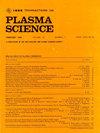Electrostatic Ion-Acoustic Waves in a Magnetized Positively Charged Dust Plasma in the Presence of Trapped Electrons
IF 1.3
4区 物理与天体物理
Q3 PHYSICS, FLUIDS & PLASMAS
引用次数: 0
Abstract
Oblique propagation of modified ion-acoustic (MIA) solitary and shock waves in magnetized dusty plasmas has been investigated theoretically. The plasma system is assumed to contain hot trapped electrons following vortex-like Schamel distribution function, warm ions, and positively charged dust (PCD) species. The linear dispersion relation for the MIA wave has been obtained. The Korteweg–de Vries (K-dV), such as Schamel equation (also known as modified K-dV equation) and modified Burgers equation, has been derived by employing the reductive perturbation method along with their corresponding solutions, which enable us to study the waves analytically and numerically. The basic features (amplitude, width, speed, polarity, and obliqueness) of ion-acoustic nonlinear waves are found to be significantly modified by different plasma parameters and are discussed briefly. The considered plasma system supports compressive solitary and shock waves only. The presence of hot trapped electrons, PCD, and warm ions raises the wave amplitude, whereas the inclusion of an external magnetic field widens the wave. The increasing viscosity of a medium broadens the wave. The findings of this investigation may be implied in interpreting various nonlinear phenomena formed in many space environments, such as aurora and Saturn’s rings, and laboratory devices, such as tokamaks.存在俘获电子的磁化正电荷尘埃等离子体中的静电离子声波
从理论上研究了改性离子声(MIA)孤立波和冲击波在磁化尘埃等离子体中的倾斜传播。假设等离子体系统包含热捕获电子,遵循涡旋状Schamel分布函数、热离子和带正电的尘埃(PCD)物种。得到了MIA波的线性色散关系。Korteweg–de Vries(K-dV),如Schamel方程(也称为修正的K-dV方程)和修正的Burgers方程,是通过使用还原微扰方法及其相应的解导出的,这使我们能够对波进行分析和数值研究。发现离子声非线性波的基本特征(振幅、宽度、速度、极性和倾斜度)被不同的等离子体参数显著改变,并对其进行了简要讨论。所考虑的等离子体系统仅支持压缩孤立波和冲击波。热捕获电子、PCD和热离子的存在提高了波的振幅,而外部磁场的加入使波变宽。介质粘度的增加使波浪变宽。这项研究的发现可能隐含在解释许多太空环境中形成的各种非线性现象中,如极光和土星环,以及实验室设备,如托卡马克。
本文章由计算机程序翻译,如有差异,请以英文原文为准。
求助全文
约1分钟内获得全文
求助全文
来源期刊

IEEE Transactions on Plasma Science
物理-物理:流体与等离子体
CiteScore
3.00
自引率
20.00%
发文量
538
审稿时长
3.8 months
期刊介绍:
The scope covers all aspects of the theory and application of plasma science. It includes the following areas: magnetohydrodynamics; thermionics and plasma diodes; basic plasma phenomena; gaseous electronics; microwave/plasma interaction; electron, ion, and plasma sources; space plasmas; intense electron and ion beams; laser-plasma interactions; plasma diagnostics; plasma chemistry and processing; solid-state plasmas; plasma heating; plasma for controlled fusion research; high energy density plasmas; industrial/commercial applications of plasma physics; plasma waves and instabilities; and high power microwave and submillimeter wave generation.
 求助内容:
求助内容: 应助结果提醒方式:
应助结果提醒方式:


